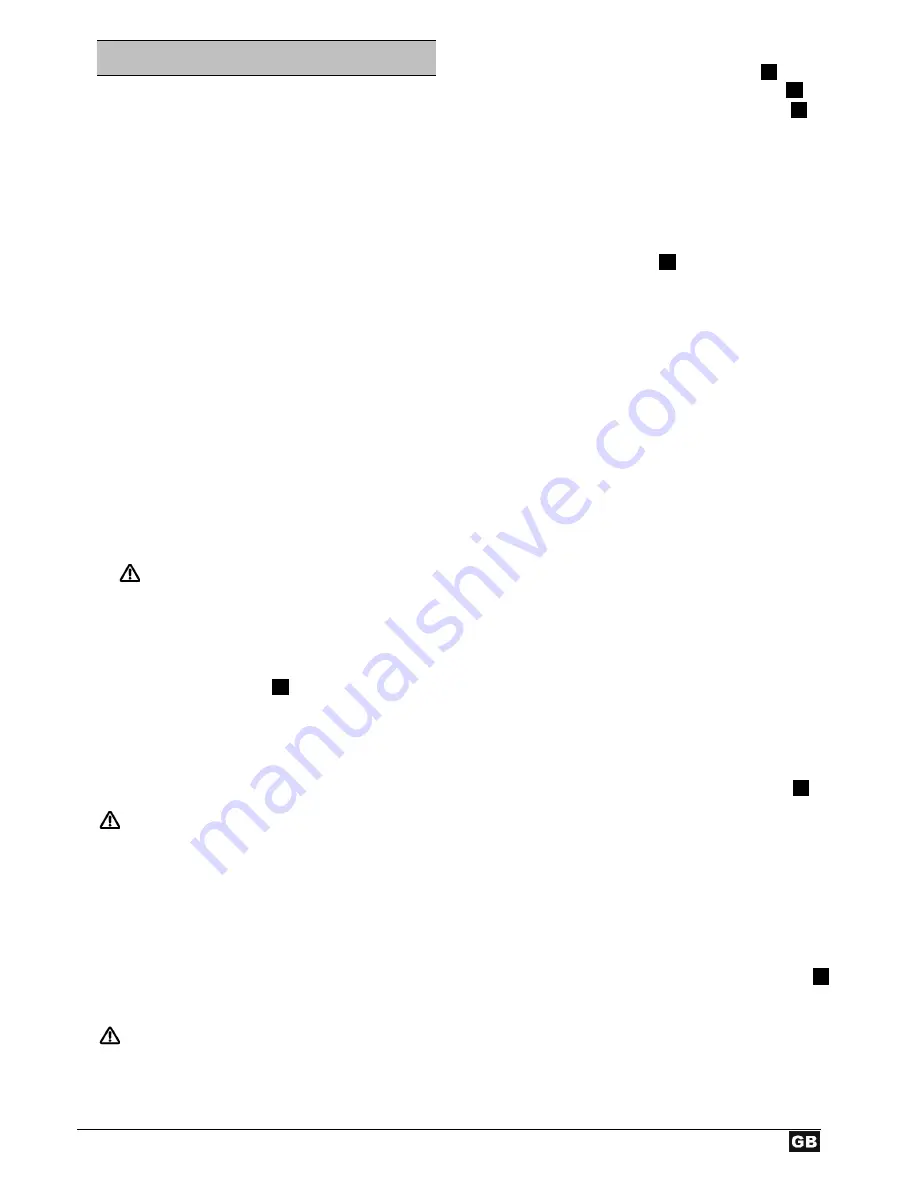
22
W
W
o
o
r
r
k
k
i
i
n
n
g
g
w
w
i
i
t
t
h
h
t
t
h
h
e
e
c
c
h
h
a
a
i
i
n
n
s
s
a
a
w
w
Before sawing
Carry out the following checks before the initiation and
regularly during the sawing process:
Is he chain saw assembled completely and
properly?
Is the chain saw in good and safe condition?
Is the oil tank filled?
Check regularly the oil level at the inspection window
(17). Replenish immediately oil when oil level indicates
„MIN“ so that the saw chain does not run dry.
Is saw chain clamped correctly?
Observe the points in paragraph „Clamping saw chain“.
Is saw chain sharpened correctly?
You only work well and safely with a sharpened saw
chain.
Is chain brake released and works properly?
The chain brake release (3) must be set to pos. 1.
Observe the points in paragraph „Checking the chain
brake“.
Is handhold clean and dry – free of oil and resin?
Is workplace free of risks to stumble?
Do you wear the required protective equipment?
Did you read and understand all advices?
Is the power plug and the extension cable in good
condition?
Do not use any defect cables
Is the extension cable correctly placed?
Connect the connector plug with the extension cable.
Then, form with the extension cable a tight noose and
push it through the safety web. Then hang the noose
into the clamp. The plug connection is now saved
against automatic release.
When carrying out the works observe that the
extension cable is always leading backwards from the
chain saw, and is outside the zone of the saw chain
and the sawing material.
Saw backstroke
What is saw backstroke? Saw backstroke is the sudden
strike upwards or backwards of the running chain saw in
direction of the operator.
This happens when
−
the sword pike gets in contact with the sawing material
(unintended) or other hard objects.
−
in case of jamming saw chain.
The chain saw reacts uncontrolled and causes frequently
heavy injuries with the operator.
Carry out lateral cuts, diagonal cuts and longitudinal
cuts with increased attention because here the claw
stopper (16) is not put on.
How to avoid saw backstroke?
−
Never try to put on the sword pike for cutting.
−
Never saw with the upper egde of the sword pike.
−
Always put on the chain saw as plane as possible.
−
Start cutting only with running saw chain.
−
Never switch on the machine with the saw chain put on.
−
Only work with sharp and correctly sharpened saw
chain.
−
Never work with loose or worn out saw chain.
−
Only work with correctly clamped saw chain.
−
Always hold the chain saw firmly with both hands.
−
Use claw stopper as lever.
−
Never work above height of shoulders.
−
Never cut through several perches at the same time.
When releasing make sure that no other perch is
touched.
−
If possible use a sawhorse when cutting to length.
−
Stab cuts shall only be carried out by instructed
personal.
General conduct when sawing
Do not work on snow, ice or recently peeled wood –
slip hazard.
Do not work under insufficient light conditions (e.g. fog,
rain, snow flurry or twilight). You can not see anymore
details within the falling area – risk of accident.
Provide for a safe and cleaned workplace.
Avoid abnormal posture. Keep at any time the balance.
Do not work with the upper part of the body leaned
forward.
Operate the chain saw only with safe standing position.
Hold the chain saw slightly on the right of the own
body.
Do not use the chain saw for lifting or moving of wood.
Make sure that the wood is free of foreign object
(stones, nails etc).
Hold the chain saw always firmly with both hands, left
hand on the front handhold (4) and right hand on the
rear handhold (17). Never saw with only one hand.
Make sure that the wood can not turn when sawing.
Saw splintered wood with care. There is risk of injury by
wood pieces carried away.
Initiate saw chain before getting in contact with the
wood.
Only cut the sawing material with the lower edge.
Cutting with the upper edge causes saw backstrokes.
Put on the chain saw as plane as possible.
Use the claw stopper (16) for fixing the chain saw on
the wood. Use the claw stopper when sawing as lever.
When sawing thicker perches or trunks set back the
claw stopper (16) on a deeper point. For setting back
release the claw stopper from the wood and place it
again in a deeper position. Do not remove the saw here
out of the cut.
11
13
15
16
12
16
14
Summary of Contents for KS 2000-40 -
Page 3: ...2 1 2 3 4 5 6 7 8 ...
Page 4: ...3 9 10 11 12 13 14 15 16 ...
Page 155: ...154 ...
Page 156: ...155 ...
Page 157: ...156 ...
















































